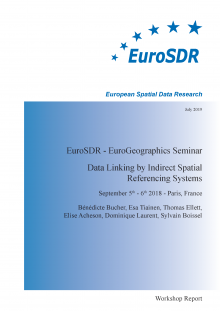Workshop report - Data Linking by Indirect Spatial Referencing Systems (2019)
An indirect spatial reference (ISR) is any way to describe a location without using coordinates. It can be the name of a located feature (for example "Zürich") or a code that identifies a located feature (such as a zip code). Place names in particular are one of the most ancient spatial referencing frameworks, to reference a person by the name of her birth place, to reference a legal document by the name of the place it was signed. As opposed to coordinates, indirect spatial referencing is well adapted to provide references readable by humans. The scientific and technological evolutions in information infrastructures come with new opportunities for using indirect spatial referencing systems to interconnect pieces of information. Indeed, every feature that has an unambiguous identifier and an unambiguous location (e.g. a named place, an address, an administrative unit, a building) can be used for the indirect spatial referencing of other features, and more and more features satisfy such conditions; they have unambiguous identifiers because of the semantic web and they have unambiguous location thanks to geocoding services and to collaborative platforms where people can discuss and reach some consensus. The evolutions in information infrastructures also bring new requirements. The growing corpus of textual content produced by society, where spatial information is an important dimension for analysis, has led to more and more communities using indirect spatial referencing systems with new specific requirements stemming from their work.
In this context, the seminar reported here aimed at presenting and discussing results and pending issues from the literature as well as practitioners' experience in the domain of using indirect spatial referencing systems or designing them. It was co-organised by EuroSDR Commission 4 on information usage and by EuroGeographics Knowledge Exchange Network INSPIRE, in September 2018. It gathered 17 participants from 7 countries. The first day of the seminar covered key results and issues on data linking and referencing with place names. A keynote presented state of the art text-to-space methods, remaining challenges and requirements in terms of indirect spatial referencing systems. It was followed by presentations from projects and organisations in charge of designing and distributing place names databases. Some presentations targeted national scope with a priority on the usability of authoritative frameworks. Others targeted the European or international scope where national gazetteers are highly heterogeneous, with a concern for reusability and interoperability. A shared statement was the importance of improving our model of places, and of relations to places, as well as explicitly model scopes and contexts, to improve gazetteer services and handle heterogeneities. Another statement was that the competences needed to design operational applications thanks to the interconnection of a wide range of information assets -scientific papers, maps, collaborative web content, today embrace the ability to discover and use APIs, as well as the capacity to experiment and follow up technologies (e.g. triple store solutions) in order to select them. Second day enlarged the scope to other core data, like buildings, including linear referencing systems and was also devoted to wrap up and draft conclusions. A common view was that usages of the abundant assets of digital data available are still partial and restricted and data linking is a substantial way forward as it enables inter and intra domain connections through a common spatial framework. With respect to using new technologies, the presentation of different projects, including pilots, in different countries evidenced notable progression and the need for national mapping agencies to embrace new competences. Yet, this requires some investment and these investments can be difficult to fulfill when the expected benefits are theoretical and when substantial investments have already been made over many years in other technologies.

